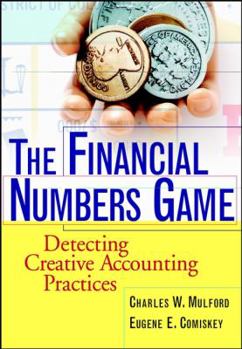The Financial Numbers Game: Detecting Creative Accounting Practices
Select Format
Select Condition 
Book Overview
Wenn vorl?ufige Sch?tzungen ergeben, dass der tats?chliche Gewinn die Erwartungen nicht erf?llt, greifen manche Manager zur St?tzung des Aktienkurses ihres Unternehmens h?ufig zu "kreativen"... This description may be from another edition of this product.
Format:Hardcover
Language:English
ISBN:0471370088
ISBN13:9780471370086
Release Date:January 2002
Publisher:John Wiley & Sons
Length:395 Pages
Weight:1.93 lbs.
Dimensions:1.3" x 7.3" x 10.2"
Customer Reviews
5 ratings
Turning over rocks by the hundreds
Published by Thriftbooks.com User , 21 years ago
In this well written book, the authors show you that there are far, far more ways of cooking a company's books that you would ever imagine. From not reserving for bad debts, to channel stuffing, to capitalizing operating costs, the ingenuity of executives apparently knows no bounds in their efforts to make things look better than they are.Just as important, the authors show you where to look in a company's financial statements for signs of the bad practices they describe.This should be a must read for anyone who does significant investing or who just wants to understand how the Enrons and Adelphias of the world manage to get away with their tricks so long.
Excellent Texts for Improving Security Analysis
Published by Thriftbooks.com User , 22 years ago
Having recently worked through all three of Mulford and Comiskey's financial reporting texts, I'd like to comment on them as a group. The Financial Reporting Game contains unique material which I have not seen outside of specialized academic journals, and discusses most of the parameters I use in my own earnings manipulation model, developed through painful experience and correspondence with other practitioners. I suggest this text as a more efficient means to acquire this knowledge. The first five chapters of introductory material discuss the motivation and consequences of earnings manipulation from the viewpoint of the regulator, the reporter, and the user of financial statements. While the preliminary chapters are less quantitative than the rest of the book, I believe they cover the subject far more comprehensively than Fridson's Financial Statement Analysis, or any other text I can recall. Guide to Financial Reporting and Analysis is indispensable, and one of the most practical texts on applied security analysis available. The efficient search procedure for non-recurring items is alone worth the cost of the book. I'm convinced that one of detriments to effective use of periodic and annual financial statements is the opacity of the notes to consolidated financial statements and their frequently indecipherable relation to the consolidated tables themselves. The authors propose and demonstrate a framework for relating complex financial notes into the core activity of the security analyst, which is measuring the sustainable earnings power of the corporation under study.Financial Warnings predates Guide to Financial Reporting and Analysis by four years. Its focus is on how corporate accounting choices can change perceptions and calculations of sustainable earnings power [and consequently stock valuation]. Financial Warnings suggests and demonstrates clear techniques for analyst restatements. I found it helpful to work through Financial Warnings after I had completed Guide to Financial Reporting, in order to test my understanding of the accounting principles discussed. To sum up, I strongly feel that if you take the time with a spreadsheet and a 10K to work along with the dozens of examples provided by the authors in each of the texts, the quality of your financial analysis will improve both in accuracy and in rigor.
Helped me understand a company's TRUE financial performance
Published by Thriftbooks.com User , 22 years ago
I really liked this book. It helped me understand how companies (like Enron) can mistate their financial results. It also shows how to get to a company's TRUE financial performance. A must read for anyone who wants to be smarter about analyzing stocks and not be blindsided by another company using creative accounting practices.
Whoa! Excellent book to explain creative accounting ...
Published by Thriftbooks.com User , 22 years ago
So what is a shareholder to believe? The analysts? The accountants? FASB? SEC? Who has our best interest at heart? And who can you trust anymore? Caveat Emptor. Buyer beware... I began a search to find the best book I could to educate me on corporate creative accounting and this is it. EZ to understand. You don't need to know debits and credits. I know what to look for now when I study 10k's. It's all in this book. Timely. Published just as Enron broke. Lots of companies mentioned, which I won't mention here. You just might be shocked at what you find out. Chapters include 'How the Game is Played', 'Misreported Assets and Liabilities', 'Getting Creative with the Income Statement, 'Earnings Management', 'Problems with Cash Flow Reporting', and many more. Complete with exhibits, charts, footnotes. EZ read. Have to go now and re-evaluate my favorite corporate annual reports!
Could not have come at a better time . . . .
Published by Thriftbooks.com User , 22 years ago
This book could not have come at a better time, given the Enron debacle shocking investors, accountants, and politicians all over the world. Mulford and Comiskey explain what signs to look for in detecting earnings manipulation. They have gathered advice from expert analysts, CFOs, and CPAs, and provide real-world examples of aggressive and fraudulent financial reports. I have long viewed Mulford and Comiskey as experts in the field, and they did not let me down in their analysis of creative accounting procedures in The Financial Numbers Game. A great book!





